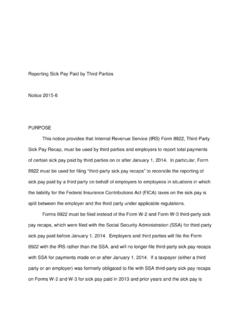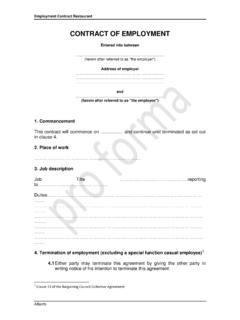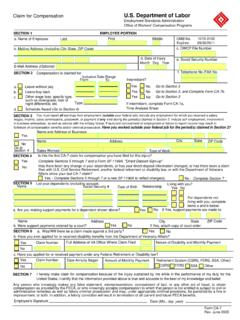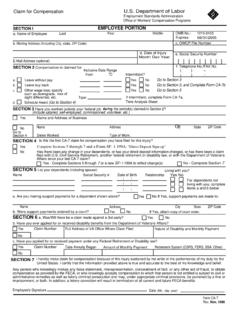Transcription of Italy - OECD.org
1 Italy Italy . Items Regulations in force on 1 January 2013. 1: Notification procedures in the case of individual Written notice to the employee. dismissal of a worker with a regular contract In the case of objective reasons (economic redundancy): the territorial employment office and the employee, are notified at the same time. Detailed reasons for dismissal are provided in the written notice. In the case of dismissal for subjective reasons ( significant non-compliance with contractual obligations ), the employee can request conciliation by the territorial employment office or through conciliation committees set up under collective agreements. 2: Delay involved before notice can start Letter sent by mail or handed directly to employee.
2 In the case of dismissals for subjective reasons ( significant non-compliance with contractual obligations ), notice can start at the earliest 5 days after the fact originating the sanction (art. 7 Law 300/70). According to most collective agreements notice starts only on 1st or the 16th day of the month ( collective agreement of metal workers, tourism industry, textile workers, chemical workers, trade industry, food industry), In the case of dismissal for objective reasons (economic redundancy) notice also to territorial employment office - TEO - (and the employee) for request conciliation procedure. Within 7 days of receiving the communication the TEO must convene a meeting between employer and employee to consider alternatives to dismissal and, failing this, try to settle the dispute without the parties going to court.
3 The procedure must be concluded within 20 days from the date the TEO sends the convocation letter, unless the parties wish to continue in order to pursue a settlement agreement. If negotiations over the settlement agreement fail or the 20-day time limit expires, the employer may send the dismissal letter to the employee. However, the date of start of the notice period will be that of the first communication to the employee and the TEO. Calculation (for EPL indicators): 1 day for letter plus 7 days on average for the 1st or the 16th day of the month plus 5/2 days for the waiting period in the case of subjective reasons. 3: Length of notice period at different tenure Length of notice period is provided by each collective agreement In most collective agreements ( durations (a) collective agreement of metal workers, tourism industry, textile workers, chemical workers, trade industry, food industry) notice is as follows: 9 months tenure: 10-75 days, 4 years tenure: 10-75 days, 20 years tenure: 30-180 days.
4 4: Severance pay at different tenure durations (a) An end-contract indemnity is paid to employees according to general principles set forth by art. 2120 of the civil code , and as provided by each collective agreement. However, this is paid upon any type of separation. Nonetheless, upon dismissal, the employer must pay a contribution equal to 41% of the monthly unemployment benefit ceiling for each of the first three years of tenure (or fraction of it). In 2013 this contribution amounts to EUR, for 9-month job tenure, and 1451 EUR for job tenure longer than 3. years ( 31 of art. 2, law 92/201, 250 of , law 228/2012, Circolare INPS No. 44, 22-03-2013). For comparison, the gross annual wage for employees with an open-ended contract was 29 852 EUR in 2012.
5 (Source ISTAT). 5: Definition of unfair dismissal (b) Fair: Termination of contract only possible for just cause or just motive , including significant non- compliance with contractual obligations by the employee (subjective reasons), and compelling business reasons (objective reasons). Unfair: Dismissals reflecting discrimination on grounds of race, religion, gender, trade union activity, etc. Law 604/66 establishes that dismissal is fair in cases of serious misconduct or for reasons concerning productive activity, work organization and its regular functioning. Except for additional provisions in Law 428/90, which sets that company delocalisation is not a fair reason for dismissal, the law is sufficiently general that case law should determine how broad the definition is.
6 The notion that repechage (that is of transfer of the redundant worker to other functions in the company) must be attempted prior to dismissal is very extensive in case law and applies also to other companies of the same group (for example: Pret. Milano 2/8/95, est. Negri della Torre; Trib. Milano 15/7/2008, Est. Casella; Cass. n. 5403/2010; Cass n. 6559/2010; n. 3040/2011; Cass. ). In the case of collective dismissals, it is an established court practice that judges verify only that the procedure has been respected (see Items 19 and 20) and do not typically examine the validity of the economic justification for redundancy, except in cases of misguided personal reasons (for example: Cass. 6/7/2000, n. 9045; Trib. Vallo della Lucania, 1/2/2011, est.)
7 De Angelis; Cass. 11/03/2011 ). 1. OECD EPL Database, update 2013. Revision: September 2015. Italy 6: Length of trial period (c ) The length of trial period is specified in each individual employment contract or collective agreements. In most collective agreements ( collective agreement of metal workers, tourism industry, textile workers, chemical workers trade industry, food industry) maximum trial period is between 30 and 180 days. 7: Compensation following unfair dismissal (d) Case of large companies (Law ): In the case of workers in companies employing >15 employees in one establishment or in the same municipality and, anyway, in companies with more than 60 employees (even if distributed in production units or municipalities with less than 15 employees), if the labour court finds that the dismissal is unfair or unjustified, it will order the employer to pay the employee an indemnity of between 12 and 24 months' salary, depending on circumstances such as age, length of service, number of employees and size of company.
8 In the case of ineffective termination of employment, due to the absence of written reasons in the termination letter or breach of procedural aspects (such as in case of disciplinary procedures), the labour court establishes an indemnity ranging from 6 to 12 months' salary, without prejudice for the application for stronger protection in the case the alleged reasons of dismissal are deemed unfair or unlawful. Reinstatement (with backpay) will be ordered instead of monetary compensation in the case of discriminatory dismissal or if the reason is manifestly false or inapplicable (see Item 8). Case of small companies: for establishments not included in the above cases, Law 604/66 gives the employer the choice between re-employment (different from reinstatement because it does not give rise to compensation for the period between the date of dismissal and the court decision) and compensation of months (depending on seniority and firm size).
9 This can be increased up to 10 months for job tenure >. 10 years. Calculation (for EPL indicators): Typical compensation at 20 years tenure (large companies): 21 months (computed as average of mean and maximum compensation, excluding the case of ineffective termination). 8: Reinstatement option for the employee following If the labour court finds that the alleged breach or failure did not take place, and should have been penalised unfair dismissal (b) by a measure less severe than dismissal according to the applicable national collective agreements or disciplinary codes or that it was a discriminatory dismissal, or that the objective reason indicated in the dismissal letter clearly does not apply or is inexistent, or that the employee was dismissed in breach of Article 2110 of Civil code (ie if the dismissal is communicated to the absent employee before the end of the provided sick leave or maternity leave), it will revoke the dismissal and will order the employer to.
10 -reinstate the employee (although the employee may refuse reinstatement and instead receive 15 months'. salary as an indemnity);. - pay employee an indemnity equal to the salary due from the date of the dismissal to the date of reinstatement, to a maximum of 12 months' salary, minus any remuneration earned by employee from working during this period (aliunde perceptum) or that he would have earned had he duly sought new employment (aliunde percipiendum);. -pay social security contributions from the date of the dismissal to the date of the reinstatement. In practice, case law suggests that reinstatement remain the most frequent remedy in the case of unfair dismissal for personal reasons and that it is often ordered also in cases of unfair dismissal for economic reasons if the proof of having attempted transfer is not provided by the employer.

















